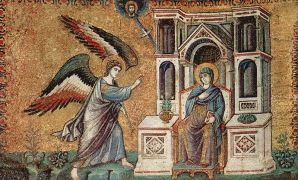By Daniel Ruff, SJ
A recurring pattern in the Spiritual Exercises has St. Ignatius starting the retreatant off praying at the “cosmic” level, and then leading him or her gradually to the more intimate and personal plane. This pattern is certainly operational in the Ignatian contemplation on the Incarnation.
Thus, as I discussed in the previous article, Ignatius invites the retreatant to enter imaginatively into the God’s-eye view of the unredeemed human condition in the first “panel” of the diptych. (I always think of those spectacular photos of the earth taken from the space shuttle.) Responding with a “leap of divine joy”1 born of love, the triune God decides to “work the redemption of the whole human race.”
 Note, then, the dramatic shift as one moves to the second “panel” of the diptych. The subject matter of the second half of the meditation is found in Luke 1:26-38, the account of the Annunciation. As Fr. Fleming puts it, “I try to stay with the eyes of God, and look upon the young girl Mary as she is greeted by God’s messenger, Gabriel.”
Note, then, the dramatic shift as one moves to the second “panel” of the diptych. The subject matter of the second half of the meditation is found in Luke 1:26-38, the account of the Annunciation. As Fr. Fleming puts it, “I try to stay with the eyes of God, and look upon the young girl Mary as she is greeted by God’s messenger, Gabriel.”
Give this a try during Advent. Be present to the scene, “hearing the nuances of the questions, seeing the expression in the face and eyes [of Mary], watching the gestures and movements which tell us so much about a person.” In other words, get to know Mary intimately—this young, simple girl from a small town whose yes to God makes possible “the redemption of the whole human race.”
Keep the cosmic sweep, the eternal significance of what the Triune God is doing, as a backdrop. But then, zoom in for the close-up on the surprising ordinariness of the scene: an obscure provincial town, a humble single-room dwelling. A young girl, not long past puberty, of ordinary lineage and meager means. As your imagination presents her, is she doing housework? Perhaps embroidering a towel? Maybe praying or daydreaming?
Into this mundane domestic setting comes the angel, Gabriel. And what is that like? Does the angel have wings, as in so many paintings? In one famous and beautiful rendering by Henry Ossawa Tanner, housed in the Philadelphia Museum of Art, the angel is depicted as a glowing column of light at the foot of the bed where an adolescent Mary is seated. How does Mary react to this divine intrusion? How would you react? Luke reports that she is “troubled” at the angel’s words and ponders, “what sort of greeting this might be.” (“Oh, Lord! What does one say to an angel? Why me? And what on earth could God possibly want?”)
Encouraging her not to be afraid, Gabriel announces that she has, “found favor with God,” and will conceive and bear a son to be named Jesus. “He will be great and will be called Son of the Most High, and the Lord God will give him the throne of David his father, and he will rule over the house of Jacob forever, and of his kingdom there will be no end.” If you were 14 or 15, what would you make of all that? Would you perhaps wonder if you were ill and hallucinating? Would you wonder, What will my parents say? And Joseph?!?
As it happens, Mary asks a practical question. How can all this come to pass? Maybe she is partly reasoning with herself. She is, after all, a virgin. The response comes, “The holy Spirit will come upon you, and the power of the Most High will overshadow you. Therefore the child to be born will be called holy, the Son of God.” Wow! Is that helpful? Is it welcome news? Or is it just scarier and more confusing? Yet somehow, Mary finds the inner courage and strength and faith to respond, “Behold, I am the handmaid of the Lord. May it be done to me according to your word.”
As you immerse yourself in the mystery of the Incarnation in your mind’s eye, “[you] may want just to stay with Mary or with the eternal Word, who has now become human—for [you]. [You] may want to speak out [your] joy, [your] thanks, [your] wonder, or [your] praise to the three Divine Persons.” The human race waited for centuries of struggle and hope until God made this astonishing and utterly unpredictable move. Allow yourself to wait on God’s grace this Advent, hoping and trusting that you will be granted deeper understanding of what all the Christmas fuss is really about.
1 All textual quotes from David L. Fleming, SJ, Draw Me Into Your Friendship: A Literal Translation and a Contemporary Reading of the Spiritual Exercises, St. Louis: Institute of Jesuit Sources, 1996.
Originally appeared in the bulletin of Old St. Joseph’s Church in Philadelphia ©2008 Fr. Daniel Ruff, SJ. Used with permission.
Related Links
Contemplation on the Incarnation Part One: The Trinity Looks Down from Heaven by Daniel Ruff, SJ
Mary at Her Annunciation as a Model for Growing in the Virtue of Faith by Gerald M. Fagin, SJ
